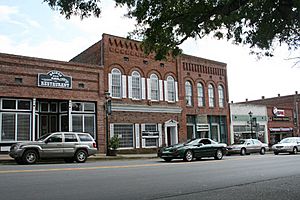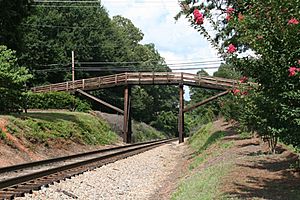Waxhaw, North Carolina facts for kids
Quick facts for kids
Waxhaw, North Carolina
|
|
|---|---|

Downtown Waxhaw
|
|
| Motto(s):
"Proud of Our Past. Passionate About Our Future."
|
|

Location of Waxhaw, North Carolina
|
|
| Country | United States |
| State | North Carolina |
| County | Union |
| Incorporated | 1889 |
| Named for | Waxhaw people |
| Government | |
| • Type | council-manager |
| Area | |
| • Total | 12.22 sq mi (31.65 km2) |
| • Land | 12.13 sq mi (31.42 km2) |
| • Water | 0.09 sq mi (0.23 km2) |
| Elevation | 584 ft (178 m) |
| Population
(2020)
|
|
| • Total | 20,534 |
| • Density | 1,692.69/sq mi (653.58/km2) |
| Time zone | UTC-5 (Eastern (EST)) |
| • Summer (DST) | UTC-4 (EDT) |
| ZIP code |
28173
|
| Area code(s) | 704 |
| FIPS code | 37-71460 |
| GNIS feature ID | 2406844 |
| Website | waxhaw.com |
Waxhaw is a town in Union County, North Carolina, United States. In 2020, about 20,534 people lived there. This number grew a lot, over 100%, since 2010! The town gets its name from the Waxhaw people, an Native American group who used to live in this area.
Contents
Exploring Waxhaw's Location
Waxhaw is a town in North Carolina. It covers about 11.54 square miles (31.65 square kilometers). The town is located in Union County. It is about four and a half miles south of Charlotte.
The Piedmont Region and Gold Discovery
Waxhaw is in the Piedmont region of North Carolina. This area has many trees and rolling hills. It's famous because it's where gold was first found in the United States! The Howie Gold Mine is close to Waxhaw. By 1935, over 50,000 ounces of gold had been dug up there. The mine stopped working during World War II.
Waxhaw's Past: A Journey Through Time
The first people to live in this area were the Waxhaw Native Americans. A Spanish explorer named Juan Pardo was the first European to meet them.
Native American History
In 1711, the Waxhaw people helped British colonists fight against the Tuscarora tribe. This made the Tuscarora's allies angry, and they started attacking the Waxhaw tribe. These attacks continued until 1715. Then, the Waxhaw joined another war against the British colony of South Carolina. This war led to the Waxhaw tribe's defeat. Their land then became open for European settlers.
Early European Settlers
Colonists started settling in the area in the mid-1700s. Most of these settlers came from Germany and Scotland/Ireland. They were farmers who grew their own food. They were known for being very independent.
Andrew Jackson, who later became the seventh President of the United States, was born nearby in 1767. There's a bit of a debate about whether he was born in North or South Carolina. However, signs around Waxhaw show his early connection to the area. You can also learn about him at the Museum of the Waxhaws. Andrew Jackson State Park is also very close to downtown Waxhaw.
The Railroad and Cotton Mills
In 1888, the railroad arrived in Waxhaw. This was a big deal! It connected the town to markets in Atlanta and helped Waxhaw become rich. The train tracks were built right through the middle of town. This showed how important the railroad was. Today, the tracks are still in the center, with green areas and shops on both sides.
Later, in the late 1800s, Waxhaw started building cotton mill factories. These factories made textiles. The railroad helped send these products to many places. Cotton manufacturing was very important until the 1940s. After World War II, the textile industry changed. Jobs moved to other parts of the country or even out of the country. This meant Waxhaw had to find new ways to grow.
Waxhaw Today: A Lively Community
Today, Waxhaw is known for its antique shops and great places to eat. A special committee is working to make the historic downtown even better. Waxhaw has many unique shops and restaurants, from small family-owned places to fancy bistros.
Historic Sites and Parks
The Waxhaw Historic District is a special area listed on the National Register of Historic Places. It includes old shops and beautiful houses near the town center. The Pleasant Grove Camp Meeting Ground is also listed.
Town leaders and residents are always working on improvements. Downtown Waxhaw has a town park and a skate park for kids and teens. Near the skate park, there's a playground and a walking path. New homes are also being built around the town.
Just outside Waxhaw, you'll find Cane Creek Park. This huge park, covering 1050 acres, has beautiful scenery and lots of fun activities. It's a great place to explore nature.
Modern Growth and Downtown Charm
Waxhaw is growing fast! Many new homes, apartments, and businesses are being built. The town grew by 6.4% in 2019 alone.
The downtown area is still built around the train tracks. There are green spaces and parking next to the tracks. You can walk over a historic bridge that goes over the train tracks. There's even a special spot to watch for trains. Even though trains don't follow a public schedule, people enjoy trying to guess when one will pass by!
Population in Waxhaw
| Historical population | |||
|---|---|---|---|
| Census | Pop. | %± | |
| 1900 | 752 | — | |
| 1910 | 602 | −19.9% | |
| 1920 | 750 | 24.6% | |
| 1930 | 840 | 12.0% | |
| 1940 | 611 | −27.3% | |
| 1950 | 818 | 33.9% | |
| 1960 | 729 | −10.9% | |
| 1970 | 1,248 | 71.2% | |
| 1980 | 1,208 | −3.2% | |
| 1990 | 1,294 | 7.1% | |
| 2000 | 2,625 | 102.9% | |
| 2010 | 9,859 | 275.6% | |
| 2020 | 20,534 | 108.3% | |
| U.S. Decennial Census | |||
2020 Census Overview
In 2020, Waxhaw had 20,534 people living in 4,773 households. The average income for a household was $116,964. This is more than double the average income for all of North Carolina!
How People Live in Waxhaw
In 2010, there were 9,859 people living in Waxhaw. About 34.6% of the people were under 18 years old. The average age was 34.5 years. Most households (81%) were married couples living together.
Local Schools in Waxhaw
Waxhaw has many schools for students of all ages.
Public Elementary Schools
- Kensington Elementary School
- Sandy Ridge Elementary School
- Waxhaw Elementary School
- Western Union Elementary School
- New Town Elementary School
- Rea View Elementary School
- Marvin Elementary School
- Prospect Elementary School
Public Middle Schools
- Marvin Ridge Middle School
- Parkwood Middle school
- Cuthbertson Middle School
Public High Schools
- Marvin Ridge High School
- South Providence High School
- Parkwood High School
- Cuthbertson High School
- Central Academy of Technology and Arts (CATA)
Private Schools
- Arborbrook Christian Academy
- Omni Montessori School
- Metrolina Christian Academy
- North Point Christian Academy
Charter Schools
- Union Day Charter School
- Union Academy
- Apprentice Academy of North Carolina
Waxhaw Library
The Waxhaw branch of the Union County Public Library opened in 1937. It was supported by the Waxhaw Womens Club and a federal program called the Works Progress Administration (WPA). You can find it at 509 South Providence Street.
Famous People from Waxhaw
See also
 In Spanish: Waxhaw para niños
In Spanish: Waxhaw para niños


